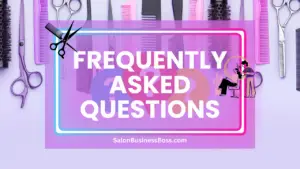Opening a hair salon can be an exciting and rewarding venture for those with a passion for hairstyling and entrepreneurship. However, like any business, starting a hair salon requires careful planning and financial preparation. One of the first and most critical considerations is the initial investment required to get the salon up and running smoothly.
The average startup costs to open a hair salon range from $25,000 to $45,000. Expenses include lease, equipment, supplies, renovations, licenses, marketing, insurance, and staff salaries. Proper financial planning is vital for a successful launch and operation.
1. Location and Lease Costs
Selecting the right location for your hair salon is a crucial decision that can significantly impact its success. The location not only determines your salon’s visibility and accessibility but also influences the type of clientele you attract. When choosing a location, consider factors such as foot traffic, nearby businesses, demographics, and the competition in the area.
Lease costs for salon spaces can vary widely depending on the city, neighborhood, and the size of the space. Prime locations in busy urban centers may command higher rent due to increased demand. On the other hand, suburban or rural areas typically offer more affordable lease options.
On average, salon owners should budget between $1,000 to $3,000 per month for lease expenses, but this can fluctuate based on the region. Urban areas and popular shopping districts may require higher budgets, while smaller towns or less sought-after locations may offer more budget-friendly lease options.
Considering the significance of location on the overall success of your salon, it is essential to research thoroughly, weigh the pros and cons, and assess how well a location aligns with your salon’s target market and brand identity. Investing in the right location can yield a high return on investment by attracting a steady stream of loyal customers and creating a strong brand presence in the community.
2. Salon Equipment and Furnishings
Equipping your hair salon with the right tools and furniture is essential to deliver top-notch services and create a comfortable and inviting atmosphere for clients. Salon equipment encompasses a range of items, including styling chairs, shampoo bowls, hair dryers, hairdressing stations, and mirrors. Additionally, furnishing the waiting area with comfortable seating and aesthetically pleasing decor adds to the overall customer experience.
When purchasing equipment and furnishings, quality should be a top priority. High-quality equipment not only enhances the customer’s experience but also ensures the safety and efficiency of your salon operations. Investing in durable and reliable equipment can prevent frequent replacements and repairs, ultimately saving costs in the long run.
The average cost for salon equipment and furnishings can vary depending on the size of your salon and the number of styling stations. On average, salon owners should allocate approximately $10,000 to $20,000 for these essential purchases. It’s essential to shop around, compare prices, and negotiate with suppliers to get the best value for your investment.
Remember that well-maintained and aesthetically pleasing salon equipment also contributes to the overall ambiance and image of your business. Clients are more likely to trust and return to a salon that maintains a clean, modern, and professional appearance.
3. Salon Supplies and Inventory
Maintaining an ample supply of salon products and consumables is vital for delivering high-quality services to clients and ensuring smooth salon operations. Salon supplies include a wide range of items, such as shampoos, conditioners, hair color, styling products, towels, capes, disposable items, and more. The specific inventory requirements depend on the size of your salon, the services offered, and the number of daily clients.
When budgeting for salon supplies and inventory, it’s essential to strike a balance between having enough stock to meet client demands and avoiding excessive waste. Proper inventory management can prevent overstocking and reduce unnecessary expenses.
For a startup hair salon, allocate approximately $2,000 to $5,000 for initial supplies. This amount may vary based on the scope of your services and the brands of products you choose to stock. It’s advisable to collaborate with reputable suppliers who offer competitive prices and discounts for bulk purchases.
Consider the shelf life of products, especially those with expiration dates, to minimize the risk of wastage. Implementing an inventory tracking system helps monitor stock levels, reorder supplies in a timely manner, and optimize costs effectively.
4. Renovation and Interior Design

Creating a visually appealing and comfortable space is crucial for attracting and retaining clients. Salon renovations and interior design play a significant role in shaping the ambiance and overall customer experience. Renovation costs can vary depending on the initial condition of the space and the desired changes.
The extent of renovation required depends on whether you’re starting from scratch in a new location or taking over an existing salon space. Renovation tasks may include painting, flooring replacement or refurbishment, lighting upgrades, and the installation of stylish fixtures.
Setting aside a budget of around $5,000 to $15,000 for renovation and interior design is a prudent approach. This allocation should cater to both functional improvements and aesthetic enhancements that align with your salon’s brand and theme.
Hiring professional interior designers or working with experienced contractors can help maximize the impact of your renovation budget. They can offer expert guidance in creating a cohesive and visually appealing space that resonates with your target clientele.
Read more about: Hair Salon Dreams Made Affordable: Cost Analysis
5. Licenses and Permits
Operating a hair salon legally requires obtaining the necessary licenses and permits from relevant authorities. These permits and licenses are vital to ensure compliance with local, state, and federal regulations, ensuring the safety of customers and staff while maintaining the integrity of the business.
The specific licenses and permits needed can vary depending on the location and the services offered by the salon. Generally, you’ll need a business license to legally operate, health permits to ensure sanitary practices, and salon operation permits to comply with industry-specific regulations. Additional permits may be required if you offer specialized services, such as nail or spa treatments.
The costs associated with obtaining licenses and permits can fluctuate depending on the region and the complexity of the application process. Some areas may have higher fees or stricter requirements, so it’s essential to research the local regulations thoroughly.
When budgeting for these expenses, it’s wise to set aside around $500 to $1,500. However, this figure may vary, so it’s crucial to assess the specific requirements in your area to avoid any unexpected financial burdens.
6. Marketing and Advertising
In the highly competitive salon industry, effective marketing and advertising are essential to attract clients and establish a strong presence. Building a recognizable brand and reaching out to potential customers are crucial for long-term success.
Investing in various marketing efforts can help spread the word about your salon. This may include creating a professional website to showcase your services and contact information. Additionally, designing business cards, flyers, and brochures can help distribute essential information to potential clients.
To increase visibility, allocating funds for both online and offline advertising campaigns is essential. Online advertising, such as social media ads and Google AdWords, can target specific demographics and increase your reach. Offline advertising, such as local newspaper ads or community event sponsorships, can also be effective in reaching the local audience.
When setting a budget for marketing and advertising costs during the initial phase, allocating approximately $2,000 to $5,000 is a reasonable approach. However, the actual amount needed will depend on the scale of your marketing efforts and the competitiveness of your local market. Consistent and strategic marketing efforts can help your salon thrive and build a loyal customer base over time.
7. Insurance and Utilities
Insurance coverage is a vital aspect of protecting your hair salon from potential risks and liabilities that could arise during its operation. General liability insurance is essential as it covers accidents or injuries that may occur on your premises, safeguarding both your clients and your business from legal and financial repercussions. Property insurance, on the other hand, protects your physical assets, such as the salon equipment and furniture, from damage or loss due to fire, theft, or other covered perils.
The cost of insurance coverage can vary depending on factors like the size of your salon, its location, the level of coverage, and the insurance provider. It’s crucial to work with a reputable insurance agent to assess your specific needs and obtain appropriate coverage.
Utilities are recurring expenses that should also be factored into your salon budget. These include electricity, water, internet services, and possibly gas or heating. The exact costs will depend on your location, the size of your salon, and the energy efficiency of your equipment.
To ensure you have a buffer for insurance and utilities expenses, budgeting around $1,500 to $3,000 annually is a practical approach. However, it’s essential to regularly review and adjust your budget based on any changes in utility rates or insurance coverage.
8. Staff Salaries and Training

When hiring employees to assist with running your hair salon, staff salaries and training costs are significant considerations. Competitive salaries are essential for attracting and retaining skilled stylists and other staff members. The salaries will vary based on factors such as experience, location, and job responsibilities.
Additionally, investing in staff training is crucial for maintaining high-quality services and keeping up with the latest trends and techniques in the industry. Training expenses may include workshops, seminars, or certification programs, particularly if you want to offer specialized services.
For a small salon with a few employees, budgeting around $10,000 to $20,000 for staff salaries and training in the first few months is a reasonable estimate. However, it’s essential to tailor this budget to your salon’s unique needs and adjust it as your business grows.
Remember that well-trained and motivated staff can contribute significantly to the success of your salon. By investing in their development and providing competitive salaries, you can foster a positive work environment and create a loyal and skilled team.
Read more about: Hair Salon Insurance Cost: Factors, Coverage, and Implications
Conclusion
Opening a hair salon requires careful financial planning to ensure a successful and sustainable business. The average startup costs for a hair salon can range from $25,000 to $45,000, depending on various factors such as location, size, and services offered. Proper allocation of funds for lease costs, salon equipment, supplies, renovations, licenses, marketing, insurance, and staff salaries is essential for a smooth launch and operation of your salon. By diligently managing the initial investment, you increase the likelihood of turning your passion for hairstyling into a thriving and profitable business.
Frequently Asked Questions

1. Can the startup cost be reduced for a smaller salon?
Yes, starting a smaller salon with fewer services can help reduce the overall startup cost.
2. Are there financing options available for opening a hair salon?
Yes, you can explore small business loans, grants, or investors to secure financing for your salon.
3. How can I effectively manage startup expenses?
Create a detailed business plan, prioritize essential expenditures, and consider phased expansions to manage costs efficiently.
To learn more on how to start you own salon checkout my startup documents here.
Please note that the contents of this blog are for informational and entertainment purposes only and should not be construed as legal advice. Any action taken based on the information provided in this blog is solely at your own risk. Additionally, all images used in this blog are generated under the CC0 license of Creative Commons, which means they are free to use for any purpose without attribution.

About the author. Entrepreneur and Salon Business Fan.
Hi! I am Shawn and I am a happy individual who happens to be an entrepreneur. I have owned several types of businesses in my life from a coffee shop to an import and export business to an online review business plus a few more and now I create online salon business resources for those interested in starting new ventures. It’s demanding work but I love it. I do it for those passionate about their business and their goals. That’s why when I meet a salon business owner, I see myself. I know how hard the struggle is to retain clients, find good employees and keep the business growing all while trying to stay competitive.
That’s why I created Salon Business Boss: I want to help salon business owners like you build a thriving business that brings you endless joy and supports your ideal lifestyle.

